History/Memories/Travelogues

|
|
|
| Writer |
: à¦à¦®. ফয়জà§à¦° রহমান |
| ISBN |
: 978-984-90879-4-6 |
| Year of Publication |
: February 2014 |
| Cover Design |
: Golam kabir |
| Size |
: 8.5"X5.5" |
| Price |
: Tk. 300 (hardback) / US$ 10 |
|
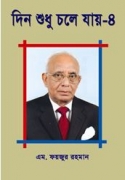 |
| |
|
দিন শà§à¦§à§ চলে যায়-৪
সাধারণত: ডায়রীকে দৈননà§à¦¦à¦¿à¦¨ কাজের ফিরিসà§à¦¤à¦¿ হিসেবে ধরা হয়। কিনà§à¦¤à§ à¦à¦–ানে দেখা যায় লেখক তার ডায়রীকে দৈননà§à¦¦à¦¿à¦¨ কাজের সমষà§à¦Ÿà¦¿à¦° মধà§à¦¯à§‡ রাখবার পকà§à¦·à¦ªà¦¾à¦¤à§€ নন। দেখা যাচà§à¦›à§‡, লেখকের মতে জীবন মানেই মানà§à¦·à¦•à§‡ ঘিরে যত কিছৠদà§à¦¨à¦¿à§Ÿà¦¾à¦¤à§‡ আছে তার পà§à¦°à¦¤à¦¿à¦Ÿà¦¿à¦° সমà§à¦®à¦¿à¦²à¦¿à¦¤ পà§à¦°à¦¤à¦¿à¦«à¦²à¦¨à¥¤ তাই à¦à¦–ানে বà§à¦¯à¦•à§à¦¤à¦¿ আছে, পরিবার আছে, দেশ আছে, পৃথিবী আছে, আছে কাজ করার, বেà¦à¦šà§‡ থাকার সংগà§à¦°à¦¾à¦®à¥¤ আছে হৃদয়, সà§à¦¨à§‡à¦¹, অনà§à¦à§‚তি, আননà§à¦¦, আরà§à¦¤à¦¨à¦¾à¦¦, বিষাদ, উপà¦à§‹à¦— যনà§à¦¤à§à¦°à¦£à¦¾ সব কিছà§à¥¤ আর à¦à¦¸à¦®à¦¸à§à¦¤à¦‡ আসে দৈননà§à¦¦à¦¿à¦¨ জীবনের আবরà§à¦¤à§à¦¤à§‡à¥¤ তাই à¦à¦Ÿà¦¾ à¦à¦• বà§à¦¯à¦¤à¦¿à¦•à§à¦°à¦®à¦§à¦°à§à¦®à§€ ডায়রী। জীবনকে, জীবনের কাজকরà§à¦®à¦•à§‡ বরà§à¦£à¦¨à¦¾à§Ÿ আনার আর রহসà§à¦¯à¦•à§‡ খà§à¦œà§‡ পাবার à¦à¦• অà¦à¦¿à¦¬à§à¦¯à¦•à§à¦¤à¦¿à¥¤ |
|
| Writer |
: ড. আবà§à¦¦à§à¦² মোছাবà§à¦¬à§‡à¦° চৌধà§à¦°à§€ |
| ISBN |
: 978-984-90880-4-2 |
| Year of Publication |
: May 2014 |
| Cover Design |
: Golam Sarwar |
| Size |
: 8.5"X5.5" |
| Price |
: Tk. 325 (hardback) / US$ 10 |
|
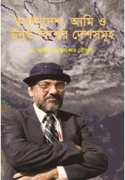 |
| |
|
বাংলাদেশ, আমি ও উনà§à¦¨à¦¤ দেশসমূহ
বাংলাদেশ, আমি ও উনà§à¦¨à¦¤ দেশসমূহ শীরà§à¦·à¦• গà§à¦°à¦¨à§à¦¥à¦Ÿà¦¿ ড. আবà§à¦¦à§à¦² মোছাবà§à¦¬à§‡à¦° চৌধà§à¦°à§€ রচিত মানবিকতার সà§à¦¬à¦°à§à¦£à¦¾à¦²à¦¿ আখরে উৎকীরà§à¦£ তাà¦à¦° জীবন চরিত। যে জীবন সতত অসহায় মানà§à¦·à§‡à¦° চিরকালের সমসà§à¦¯à¦¾ দà§à¦°à§à¦¯à§‡à¦¾à¦— পà§à¦°à¦¶à¦®à¦¨à§‡ জà§à¦žà¦¾à¦¨ অà¦à¦¿à¦œà§à¦žà¦¤à¦¾ পà§à¦°à§Ÿà§‹à¦—ে সমাধান খà§à¦à¦œà§‡ ফেরে। তাà¦à¦° নিজ জীবনের নানা ঘটনা পà§à¦°à¦¬à¦¾à¦¹à§‡à¦° মধà§à¦¯ দিয়ে তাà¦à¦° গবেষণার বিষয় টà§à¦°à¦ªà¦¿à¦•à§à¦¯à¦¾à¦² সাইকà§à¦²à§‹à¦¨ à¦à¦¬à¦‚ অনà§à¦¯à¦¾à¦¨à§à¦¯ পà§à¦°à¦¾à¦•à§ƒà¦¤à¦¿à¦• দà§à¦°à§à¦¯à§‹à¦— মোকাবেলায় পৃথিবীময় রাষà§à¦Ÿà§à¦° থেকে রাষà§à¦Ÿà§à¦°à§‡ তার উদà§à¦à¦¾à¦¬à¦¿à¦¤ ততà§à¦¤Â¡ পà§à¦°à¦šà¦¾à¦° ও পà§à¦°à¦•à¦¾à¦¶à§‡à¦° বিষয়গà§à¦²à§‹ গà§à¦°à¦¨à§à¦¥à¦Ÿà¦¿à¦¤à§‡ অনবদà§à¦¯à¦à¦¾à¦¬à§‡
উঠে à¦à¦¸à§‡à¦›à§‡à¥¤
১৯à§à§¦ à¦à¦° ঘূরà§à¦£à¦¿à¦à§œ তাà¦à¦° জীবনের মোড় পরিবরà§à¦¤à¦¨ করে দেয়। তাà¦à¦° উদà§à¦à¦¾à¦¬à¦¿à¦¤ জড়ংব চবঃধষ ঞযবড়ৎà§-র সাহাযà§à¦¯à§‡ গà§à¦°à§€à¦·à§à¦®à¦®à¦¨à§à¦¡à¦²à§‡ ঘূরà§à¦£à¦¿à¦à§œ বা সাইকà§à¦²à§‹à¦¨à§‡à¦° সঠিক ও যথাযথ পূরà§à¦¬à¦¾à¦à¦¾à¦¸ পাওয়া সমà§à¦à¦¬à¥¤ আবহাওয়া সংকà§à¦°à¦¾à¦¨à§à¦¤ তাà¦à¦° জà§à¦žà¦¾à¦¨, অà¦à¦¿à¦œà§à¦žà¦¤à¦¾ ও গবেষণা বাসà§à¦¤à¦¬à¦¤à¦¾à¦° নিরিখেও যে কত তাৎপরà§à¦¯à¦ªà§‚রà§à¦£ তা ১৯৯ৠসালের ঘূরà§à¦£à¦¿à¦à§œà§‡ পূরà§à¦¬à¦¾à¦à¦¾à¦¸ হিসেবে পà§à¦°à§Ÿà§‹à¦—ের ফলে যে পà§à¦°à§Ÿà¦²à¦‚কারী দূরà§à¦¯à§‡à¦¾à¦—েও কà§à¦·à§Ÿà¦•à§à¦·à¦¤à¦¿ বà§à¦¯à¦¾à¦ªà¦•à¦à¦¾à¦¬à§‡ হà§à¦°à¦¾à¦¸ করা সমà§à¦à¦¬ হয়েছিল। ঠসকল বরà§à¦£à¦¨à¦¾ বিশদà¦à¦¾à¦¬à§‡ à¦à¦¸à§‡à¦›à§‡ গà§à¦°à¦¨à§à¦¥à¦Ÿà¦¿à¦¤à§‡à¥¤
গà§à¦°à¦¨à§à¦¥à¦Ÿà¦¿à¦° আখà§à¦¯à¦¾à¦¨à¦à¦¾à¦—কে বিà¦à¦¿à¦¨à§à¦¨ শিরোনামে যে ছোট ছোট অনà§à¦šà§à¦›à§‡à¦¦à§‡ à¦à¦¾à¦— করা হয়েছে, তা বইটিকে করেছে সহজবোধà§à¦¯ ও গতিময়। ঠবইয়ের à¦à¦•à¦Ÿà¦¿ গà§à¦°à§à¦¤à§à¦¬à¦ªà§‚রà§à¦£ দিক হল বিà¦à¦¿à¦¨à§à¦¨ দেশ সমà§à¦ªà¦°à§à¦•à§‡ তাà¦à¦° পà§à¦°à¦¤à§à¦¯à¦•à§à¦· অà¦à¦¿à¦œà§à¦žà¦¾à¦¤à¦¾à¦ªà§‚রà§à¦£ অà¦à¦¿à¦®à¦¤à¥¤ সেসব দেশের উনà§à¦¨à§Ÿà¦¨à§‡à¦° নৈপথà§à¦¯ চিতà§à¦°, শিকà§à¦·à¦¾ বà§à¦¯à¦¬à¦¸à§à¦¥à¦¾, সমাজনীতি, শিলà§à¦ªà¦¨à§€à¦¤à¦¿, রাজনীতি মূরà§à¦¤ হয়ে উঠেছে তাà¦à¦° অসাধারণ মিতবà§à¦¯à§Ÿà§€ বরà§à¦£à¦¨à¦¾à§Ÿà¥¤
শৈশবের নষà§à¦Ÿà¦¾à¦²à¦œà¦¿à¦• সময়কে রোমনà§à¦¥à¦¨ করতে কে না à¦à¦¾à¦²à§‹à¦¬à¦¾à¦¸à§‡? লেখক শৈশব থেকে তাà¦à¦° বেড়ে ওঠাÑসà§à¦•à§à¦², কলেজ জীবন, বিশà§à¦¬à¦¬à¦¿à¦¦à§à¦¯à¦¾à¦²à§Ÿ জীবনের অসমà§à¦à¦¬ মেধাবী ছাতà§à¦°à¦Ÿà¦¿ তাà¦à¦° গবেষণা করà§à¦®à§‡à¦° মাধà§à¦¯à¦®à§‡ আনà§à¦¤à¦°à§à¦œà¦¾à¦¤à¦¿à¦• খà§à¦¯à¦¾à¦¤à¦¿ পেয়েও যে গà¦à§€à¦° দেশাতà§à¦¬à¦¬à§‹à¦§ ও চেতনায় জারিত হয়ে নিজ দেশে মাটির টানে বার বার ফিরে à¦à¦¸à§‡à¦›à§‡à¦¨- তার গà¦à§€à¦° বরà§à¦£à¦¨à¦¾ রয়েছে গà§à¦°à¦¨à§à¦¥à¦Ÿà¦¿à¦¤à§‡à¥¤
ঠগà§à¦°à¦¨à§à¦¥ পাঠে গণমানà§à¦·à§‡à¦° পà§à¦°à¦¤à¦¿, দেশের পà§à¦°à¦¤à¦¿ à¦à¦¬à¦‚ করà§à¦®à§‡à¦° পà§à¦°à¦¤à¦¿ সবারই যে à¦à¦• আশà§à¦šà¦°à§à¦¯ অঙà§à¦—ীকার রয়েছে তাকে পূনরà§à¦¬à¦¾à¦° সà§à¦®à¦°à¦£ করিয়ে দেবে বলে আমাদের বিশà§à¦¬à¦¾à¦¸à¥¤ |
|
| Writer |
: Farida Huq |
| ISBN |
: 984 08 0179 1 |
| Year of Publication |
: 2010 (third print) |
| Cover Design |
: Golam Kabir |
| Size |
: 8.7"X5.5" |
| Price |
: Tk. 400 (hardback), US$ 20 |
|
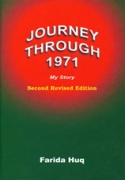 |
| |
|
Journey Through 1971 My Story
The journey began on that fateful night of 25th March 1971 when I with my little kids had to leave our home and take shelter in my aunt’s house. It was an endless journey of trials and tribulations through the then East Pakistan and beyond. The journey continued taking me to West Pakistan. For days and months, life meant nothing but miseries and meaningless. Finally the time had come to return home and set foot on the sacred soil of our beloved and independent homeland Bangladesh. |
|
| Writer |
: M Manzur-i-Khuda |
| ISBN |
: 984 08 0260 7 |
| Year of Publication |
: 2010 |
| Cover Design |
: Golam Kabir |
| Size |
: 8.7"X5.5" |
| Price |
: Tk. 250 (hardback), US$ 10 |
|
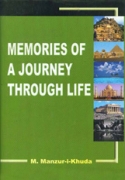 |
| |
|
Memories of a Journey through life
This book is author’s journey of life through Time. It is the memories of his life story, with its ups and downs together with the travel and residencies in the East and the West. It is only an effort to bring some of his understanding, as he believes that the knowledge of Science, Religion and Spiritual guidance are all essential part of a worldly life. War is a mechanism to enforce one’s own will. Love and persuasion can succeed where force and destruction fails. A proper analysis with goodwill can succeed in correcting a misleading understanding of religious of other social practices.
The general readers will find the book knowledgeable, informative and interesting.
|
|
| Writer |
: Habibul Alam, Bir Pratik |
| ISBN |
: 984 08 0201 1 |
| Year of Publication |
: 2012 |
| Cover Design |
: Golam Kabir &
Mohiuddin Ahmed |
| Size |
: 8.7"X5.5" |
| Price |
: Tk. 375 (Paperback), US$ 20 |
|
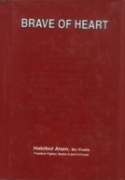 |
| |
|
Brave of Heart
Habibul Alam, Bir Pratik, born in May 1950. Mr. Alam is married and blessed with two children. He is a successful businessman and has been involved with the Scout Movement since his school days, he was elected as the Vice Chairman and now member of the World Scout Committee for a period of six year. He has been recognized with highest awards from a number of countries for his dedication and contributions to the Scout Movement globally.
While studying in the Dhaka University he joined the Liberation War as early as April 1971 under the command of Sector-2 and K-Forces. He led the first group of 17 boys that came inside Dhaka during end May 1971 to fight the enemy soldiers in the heart of Dhaka City. It was for his active participation and bravery in the war of Liberation in 1971 that the Government of the Peoples’ Republic of Bangladesh awarded him the gallantry award ‘Bir Pratik’.
|
|
| Writer |
: Habiba Khutun |
| ISBN |
: 984 08 0212 6 |
| Year of Publication |
: 2006 |
| Cover Design |
: Hafiza Khatun |
| Size |
: 8.7"X5.5" |
| Price |
: Tk. 375 (hardback), US$ 20 |
|
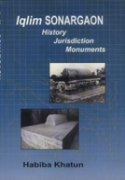 |
| |
|
Iqlim Sonargaon
History, Jurisdiction, Monuments
‘Iqlim Sonargaon; History, Jurisdiction and Monuments’ by Dr. Habiba Khatun, Professor, Department of Islamic History and Culture, University of Dhaka mentions Sonargaon an independent state of 1338 AD. It was a vast tract of land. The city and river port developed on the bank of the great river Brahmaputra. Sultan Ilyas Shah conquered Sonargaon in 1342. He made Sonargaon an iqlim (province) of his state Bangalah or Bengal. Bangalah had three units or iqlims viz. Sonargaon, Satgaon and Lakhnawti. Giasuddin Azam Shah was appointed as provincial ruler of Sonargaon by his father Sultan Sikander Shah. The Sultan built the Adina mosque in 1375. The Sultan’s son built a stone tomb at Sonargaon and decorated it with art motif used in the Adina mosque. Sultan Sikander Shah died at a place near Sonargaon in a battle between the father and the son. Giasuddin became ruler of Bangalah and ruled from Pandua. He was killed in 1409 by Raja Gonesh. His chief wazir and general Khan al Azam Khan Jahan fortified the then south west border of iqlim Sonargaon with a ribat. He was again Ulugh Khan Jahan of Sultan Nasiruddin Mahmud Shah. Khan Jahan built many mosques and a stone tomb in the south west border of the city of Khalifatabad (modern Bagerhat) where he is identified in an epigraphic record. He died in 1459. His mosques bear the testimony of art motif of Sonargaon stone tomb and that of Pandua of the same period. Sonargaon city was extended towards north up to Katrabo, the fortified palace of Isa Khan of Sonargaon. Isa Khan masanadali was the King of Kings of Bhati. Katrabo is identified in a village of Rupganj upzila in Narayanganj district. |
|
| Writer |
: Sharif Uddin Ahmed |
| ISBN |
: 984 32 0959 1 |
| Year of Publication |
: 2010 |
| Cover Design |
: Golam Kabir |
| Size |
: 8.7"X5.5" |
| Price |
: Tk. 400 (hardback), US$ 25 |
|
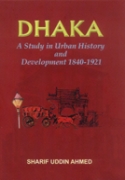 |
| |
|
Dhaka
A Study in Urban History and Development 1840-1921
Research based historical works on the cities of the subcontinent are still very few. Fewer still are the works on the history and development of cities and towns of Bangladesh. In this context professor Sharif uddin Ahmed’s book on Dhaka -History and Urban Development 1840-1921 may be taken as an exception. It is one of the few urban studies, which carries through the ‘old order ‘to the new administrative towns of British rule and attempts to show what happened to the communities of townsmen in the period of adaptation. Once a very prosperous Mughal capital Dhaka declined so sharply during the early 19th century that its very existence was threatened. But its geographical location and other factors soon led to its revival as an administrative centre. Dr. Ahmed has elaborately described and analysed this revival of a great city and its role in modern South Asia.
The work also discusses the development in Dhaka of a western-style municipal organization and its financial and practical problems and also the economic transition of the city after 1840 especially the contribution of the jute boom to its prosperity. It casts new light on the function and organisation of South Asian urban societies in the colonial period on the transfer of western institutions and on the organisation and composition of Bengal trade outside Kolkata.
Surely it is an outstanding work on the urban studies of the subcontinent.
|
|
| Writer |
: Sufia Ahmed |
| ISBN |
: 984 08 0267 4 |
| Year of Publication |
: 2011 |
| Cover Design |
: Golam Kabir |
| Size |
: 8.7"X5.5" |
| Price |
: Tk. 400 (hardback), US$ 10 |
|
 |
| |
|
Diaries of Justice Muhammad Ibrahim (1960-1966)
Justice Muhammad Ibrahim (1898-1966) had a distinguished multifaceted career as a Teacher, Lawyer, Public Prosecutor, District and Session’s Judge, Judge of the High court, Vice-Chancellor of Dhaka University and Law Minister of Pakistan in the first Cabinet of President Muhammad Ayub Khan from October 1958 to April 1962.
His handwritten Diaries recorded from 1960 to 1966 partly cover the period of Justice Ibrahim’s stint as the Law Minister during the regime of General Ayub Khan the first military ruler of Pakistan, interspersed with some personal accounts.
These entries documented minutely portray Justice Ibrahim as a committed Bengali nationalist, who passionately fought to gain support for the justifiable political and economic demands of the people of East Pakistan. The narratives give a clear idea of some unknown historical facts and incidents, which occurred during those critical days of constitutional development in Pakistan. Justice Ibrahim’s constitutional proposals reflected the prevalent mood of the Bengalis of East Pakistan. For a federal government based on some radical suggestions to this effect, to be included in the contemplated new Constitution to be framed for Pakistan. These proposals brought him into direct confrontation with his Cabinet colleagues and particularly with President Ayub Khan. As his persistent demands remained unheeded, he being disillusioned and frustrated resigned from the Cabinet in April, 1962.
|
|

|
|
|








